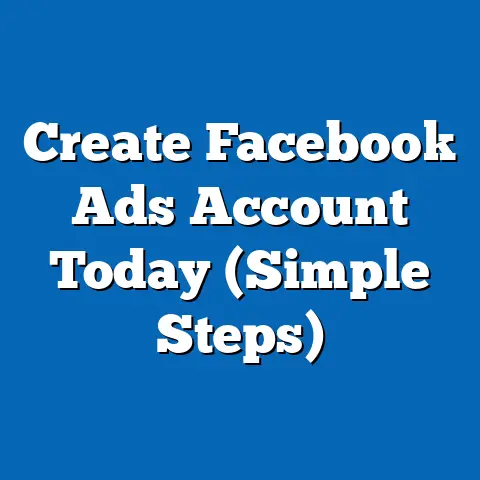Can I Mention Sales Amounts in Facebook Ads? (Expert Insights)
I’ve spent years navigating the ever-changing landscape of Facebook advertising, and one question that consistently pops up is, “Can I mention sales amounts in my Facebook ads?” It seems simple on the surface, but the answer is nuanced and depends heavily on how you approach it. Think of Facebook advertising as a layered cake, each layer representing a crucial element: captivating visuals, compelling copy, undeniable social proof, and, of course, adherence to Facebook’s advertising policies. Leaving out even one layer can result in a less-than-appetizing result.
The goal is to create a campaign that not only grabs attention but also builds trust and credibility. That’s where the allure of mentioning sales figures comes in. Who wouldn’t want to shout from the rooftops that their product has generated X amount of dollars in sales? It’s a powerful form of social proof, but it also treads a fine line with regulations and ethical considerations. Let’s dive into the intricacies of using sales amounts in your Facebook ads while staying on the right side of the rules.
Understanding Facebook’s Advertising Policies
One of the first things I learned when starting out with Facebook Ads is that you need to know the platform’s advertising policies inside and out. They’re not just suggestions; they’re the rules of the game. When it comes to making claims in your ads, Facebook is particularly stringent.
Facebook’s advertising policies aim to ensure that ads are clear, honest, and don’t mislead users. Specifically, the guidelines state that ads must not contain false, deceptive, or misleading content. This includes exaggerated claims, unsubstantiated statements, or unrealistic promises.
So, what does this mean for mentioning sales amounts? It means you can’t just pluck a number out of thin air. You need to be able to back up your claims with verifiable data. Furthermore, even if your sales figures are accurate, Facebook might still flag your ad if it perceives the claim as being overly boastful or creating unrealistic expectations.
Key Takeaway: Before you even think about mentioning sales amounts, familiarize yourself with Facebook’s advertising policies and understand the implications for your business. Authenticity and transparency are key.
The Importance of Sales Amounts in Advertising
Why are sales amounts so appealing in advertising? It all boils down to social proof. As humans, we’re naturally inclined to follow the crowd. If we see that a product or service is popular and successful, we’re more likely to be interested in it. Sales figures provide concrete evidence of this popularity.
Imagine you’re browsing Facebook and see two ads for similar products. One ad simply states that the product is “great,” while the other highlights that it has generated $1 million in sales in the past month. Which ad are you more likely to click on? Chances are, it’s the one with the sales figure.
Mentioning sales amounts can be particularly effective in certain industries. For example:
- E-commerce: Highlighting the number of units sold or the total revenue generated can create a sense of urgency and scarcity.
- SaaS: Showcasing the number of paying customers or the annual recurring revenue can build confidence in your software’s value.
- Local Businesses: Mentioning the number of customers served or the sales growth in the past year can demonstrate your business’s popularity and success within the community.
However, I’ve learned that it’s not just about throwing a number out there. It’s about context and relevance. If you’re a brand new business, boasting about $100 in sales might not have the same impact as a more established company highlighting millions.
Key Takeaway: Sales amounts serve as powerful social proof, enhancing credibility and encouraging engagement. But remember, context is king.
Legal Considerations and Compliance
Beyond Facebook’s policies, there are legal considerations to keep in mind. Truth-in-advertising laws exist to protect consumers from false or misleading claims. These laws require that any statements you make in your ads are accurate and substantiated.
Misrepresenting sales figures can have serious legal repercussions. You could face fines, lawsuits, or even be forced to cease your advertising activities altogether. It’s simply not worth the risk.
To ensure compliance, it’s essential to:
- Keep accurate records: Maintain detailed records of your sales data to support any claims you make in your ads.
- Avoid exaggeration: Don’t inflate your sales figures or make unrealistic promises.
- Be transparent: Clearly disclose any limitations or qualifications related to your sales data.
- Consult with legal counsel: If you’re unsure about the legality of your claims, seek advice from a legal professional.
From personal experience, I can tell you that it’s always better to err on the side of caution. I once worked with a client who was tempted to round up their sales figures to make them sound more impressive. I had to have a serious conversation with them about the potential legal consequences, and we ultimately decided to stick with the accurate numbers, even if they were slightly less eye-catching.
Key Takeaway: Truth-in-advertising laws require that all claims are accurate and substantiated. Ensure you have the data to back up your sales figures and avoid making misleading statements.
Strategies for Effectively Mentioning Sales Amounts
So, how can you effectively incorporate sales amounts into your Facebook ads while remaining compliant and ethical? Here are some strategies I’ve found to be successful:
- Use Specific Numbers: Instead of saying “We’ve sold a lot,” provide a specific number, such as “We’ve sold over 10,000 units.” Specific numbers tend to be more believable and impactful.
- Provide Context: Don’t just throw a number out there without context. Explain what the number means and why it’s significant. For example, “Our product has generated $500,000 in sales in the past year, helping small businesses like yours grow their revenue.”
- Highlight Growth: Instead of focusing solely on the total sales amount, highlight your sales growth. For example, “Our sales have increased by 50% in the past quarter.” This demonstrates momentum and progress.
- Use Testimonials: Combine sales figures with customer testimonials to create a more compelling narrative. For example, “Our product helped John Doe increase his sales by 30% in just one month.”
- Focus on Results: Instead of focusing on the sales amount itself, focus on the results that your product or service has achieved for your customers. For example, “Our clients have collectively generated over $1 million in revenue using our platform.”
I remember working on a campaign for a local restaurant that wanted to highlight its popularity. Instead of saying “We’re the best restaurant in town,” we focused on the number of customers served. The ad read, “Join over 50,000 satisfied customers who have enjoyed our delicious meals.” This approach was much more effective in building trust and attracting new customers.
Key Takeaway: Use specific numbers, provide context, highlight growth, combine sales figures with testimonials, and focus on the results your product or service has achieved.
Balancing Transparency with Marketing Creativity
Finding the sweet spot between transparency and marketing creativity can be challenging, but it’s essential for building a brand that people trust. You want to tell your story in a way that’s engaging and persuasive, without crossing the line into misleading or deceptive advertising.
One way to achieve this balance is to focus on showcasing your brand’s values and mission. What do you stand for? What problems are you solving? How are you making a difference in the world? By focusing on these aspects, you can create a connection with your audience that goes beyond just sales figures.
Another approach is to use alternative metrics that convey the same message without explicitly stating sales amounts. For example:
- Customer Satisfaction: Highlight your customer satisfaction ratings or the number of positive reviews you’ve received.
- Engagement: Showcase the number of social media followers, website visitors, or email subscribers you have.
- Community Impact: Highlight the positive impact your business has had on the community, such as the number of donations you’ve made or the volunteer hours you’ve contributed.
Ultimately, the goal is to create a brand that people believe in. Transparency and authenticity are key to building this trust.
Key Takeaway: Balance transparency with marketing creativity by showcasing your brand’s values, focusing on alternative metrics, and building a brand that people believe in.
Future Trends in Facebook Advertising and Sales Transparency
The world of Facebook advertising is constantly evolving, and it’s important to stay ahead of the curve. One trend that I see gaining momentum is the increased demand for transparency and authenticity from consumers.
People are becoming more skeptical of traditional advertising tactics and are looking for brands that are genuine and trustworthy. This means that businesses need to be more transparent about their practices, their values, and their results.
I believe that in the future, Facebook will likely place even greater emphasis on transparency and authenticity in advertising. This could mean stricter enforcement of existing policies, new regulations regarding claims, or even new tools and features that help consumers verify the accuracy of ad claims.
Businesses that embrace transparency and authenticity will be well-positioned to succeed in the long run. Those that continue to rely on misleading or deceptive tactics will likely face increasing scrutiny and backlash.
Key Takeaway: The future of Facebook advertising will likely be shaped by increased demand for transparency and authenticity. Businesses that embrace these values will be best positioned for success.
The Takeaway for Advertisers
So, can you mention sales amounts in your Facebook ads? The answer is yes, but with caution. You need to be aware of Facebook’s advertising policies, comply with truth-in-advertising laws, and use effective strategies for incorporating sales figures into your ads.
Remember that transparency and authenticity are key to building trust with your audience. Focus on showcasing your brand’s values, highlighting the results you’ve achieved for your customers, and building a brand that people believe in.
By following these guidelines, you can effectively leverage the power of sales amounts in your Facebook ads while staying on the right side of the rules.
Engage with the Community
Now, I’d love to hear from you. Have you ever mentioned sales amounts in your Facebook ads? What were the results? What challenges did you face? Share your experiences and insights in the comments below. Let’s learn from each other and build a community of ethical and effective Facebook advertisers.






